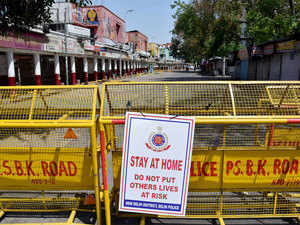
As more become unemployed and the economy plunges, we will all be able to afford much less, also leading to lower-quality healthcare for everyone. Politically, the outcome could be dire — the previous long-term recessions in the 1920-30s didn’t end well.

COVID-19 CASES
WorldIndiaConfirmed4,067Deaths109Confirmed1,272,115Deaths69,374Bjørn Lomborg
The potential impact of the Covid-19 pandemic is enormous. But draconian policies to tackle the virus also have colossal costs. Ignoring the trade-offs could land us with one of the worst possible outcomes.
An Imperial College study (bit.ly/2V5nrKG) on death impacts from different policies showed that without any policies, the coronavirus would kill 500,000 people in Britain and 2.2 million in the US. Unrestricted Covid-19 means most people get sick at the same time, entirely overwhelming the health care system. Without restrictions, corona infections are projected to peak in early June in Britain, with 280,000 sick people needing hospitalisation, but only 8,000 beds available. That is why it is crucial to ‘flatten the curve’. Policies to reduce the speed of infection can help spread out when people get sick and make hospital beds available for more people who need it.
Smart policies like self-isolation, house quarantines and isolation for the vulnerable have little cost and can flatten the curve somewhat, reducing deaths by 50%. But this still leads to 250,000 dead in Britain. So understandably, almost all societies have decided that stronger, general policies are needed.
Imperial College defines ‘social distancing’ of the entire population to mean that people still go to school and mostly to work, but they curtail other social interactions like going to restaurants, cinemas and bars by 75%. Together with other smart policies, this could flatten the curve in Britain so much that there are almost enough beds for everyone for the next five months in that country.

Unfortunately, the study also shows that such a successful reduction in infection means few people have gained immunity. So, if restrictions are lifted in September, a second wave of infections may once again overwhelm society and kill almost as many.
So, if we want to keep deaths low, we may have to
maintain social restrictions for most of what could be a two-year wait before vaccinations are hopefully available. This point needs more emphasis. Up to two years of draconian social restrictions will not only be phenomenally costly, but also impossibly hard to keep in place.
Look at the costs first. Most of the early predictions were moderate. But the world’s much more severe policies have exploded the costs. According to JPMorgan, China’s economy will shrink by 40% in Q1 FY2020-21. For the US, Goldman Sachs now envisages a 24% Q2 GDP reduction, and Morgan Stanley a 30% drop. Ten million Americans filed for unemployment benefits over the last two weeks.
Moreover, most governments seem to have committed to draconian policies to avoid most deaths over the long term. These will cost much, much more. If China wants to reopen, it risks a second wave of corona. If it doesn’t, the economic contraction could continue or get worse. Economists are now suggesting the costs of continued extreme policies could be comparable to Germany in the 1920s or the US in the 1930s, with massive economic costs, a third of the workforce unemployed and a generational loss of opportunities.
These policies cannot realistically be sustained for many months, let alone years. Already, cellphone-tracking shows that 40% of Italians still move around, despite curfews and lockdowns. In France, ‘virus rebels’ are defying bans and young Germans hold ‘corona parties’ while coughing at older people.
As weeks of shutdown turn into months, this will get much worse. With many more people at home, this will likely lead to higher levels of domestic violence and substance abuse. As schools stay closed, the skills of the next generation erode. A 2010 study (bit.ly/3bPsnKD) published in Health Economics shows closing schools in Britain for just 13 weeks could initially cost the British economy 8.1% of GDP.
As more become unemployed and the economy plunges, we will all be able to afford much less, also leading to lower-quality healthcare for everyone. Politically, the outcome could be dire — the previous long-term recessions in the 1920-30s didn’t end well.
We need to discuss the trade-offs between tougher shut-downs and economic calamity openly. On Saturday, Trump considered relaxing social distancing rules for Easter services next week. It could help the economy in the short-term. But long-term, it could lead to the catastrophe forecasted by the Imperial College study.
Long-term shutdown policies can similarly lead to devastation: first destroying the economy, and then with their support withering and health regulations unravelling by September, a huge secondary wave of corona killing indiscriminately. Fortunately, the study maps out more of a middle ground. It didn’t advocate the complete shutdown we are mostly seeing implemented. The researchers envisioned people mostly working, while reducing their social activities. They pointed out that cancelling mass gatherings have ‘relatively little impact’ because ‘the contact-time at such events is relatively small compared to the time spent at home, in schools or workplaces etc’.
This middle ground is more like what Sweden has been doing — recommending people to work from home if possible, and asking those who are sick and over-70 to avoid social contacts. But most people still work, children go to school, most of society is still running. This is long-term sustainable. Shutting everything down is not.
We need to map a middle course that
both saves most lives <and> avoids a catastrophic recession.
The writer is visiting fellow, Hoover Institution, Stanford University, US
Source: indiatimes.com

